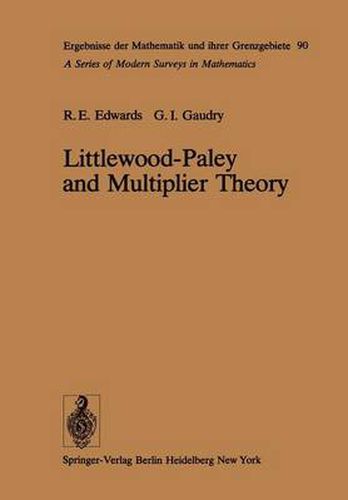Readings Newsletter
Become a Readings Member to make your shopping experience even easier.
Sign in or sign up for free!
You’re not far away from qualifying for FREE standard shipping within Australia
You’ve qualified for FREE standard shipping within Australia
The cart is loading…






This title is printed to order. This book may have been self-published. If so, we cannot guarantee the quality of the content. In the main most books will have gone through the editing process however some may not. We therefore suggest that you be aware of this before ordering this book. If in doubt check either the author or publisher’s details as we are unable to accept any returns unless they are faulty. Please contact us if you have any questions.
This book is intended to be a detailed and carefully written account of various versions of the Littlewood-Paley theorem and of some of its applications, together with indications of its general significance in Fourier multiplier theory. We have striven to make the presentation self-contained and unified, and adapted primarily for use by graduate students and established mathematicians who wish to begin studies in these areas: it is certainly not intended for experts in the subject. It has been our experience, and the experience of many of our students and colleagues, that this is an area poorly served by existing books. Their accounts of the subject tend to be either ill-suited to the needs of a beginner, or fragmentary, or, in one or two instances, obscure. We hope that our book will go some way towards filling this gap in the literature. Our presentation of the Littlewood-Paley theorem proceeds along two main lines, the first relating to singular integrals on locally com pact groups, and the second to martingales. Both classical and modern versions of the theorem are dealt with, appropriate to the classical n groups IRn, ?L , Tn and to certain classes of disconnected groups. It is for the disconnected groups of Chapters 4 and 5 that we give two separate accounts of the Littlewood-Paley theorem: the first Fourier analytic, and the second probabilistic.
$9.00 standard shipping within Australia
FREE standard shipping within Australia for orders over $100.00
Express & International shipping calculated at checkout
This title is printed to order. This book may have been self-published. If so, we cannot guarantee the quality of the content. In the main most books will have gone through the editing process however some may not. We therefore suggest that you be aware of this before ordering this book. If in doubt check either the author or publisher’s details as we are unable to accept any returns unless they are faulty. Please contact us if you have any questions.
This book is intended to be a detailed and carefully written account of various versions of the Littlewood-Paley theorem and of some of its applications, together with indications of its general significance in Fourier multiplier theory. We have striven to make the presentation self-contained and unified, and adapted primarily for use by graduate students and established mathematicians who wish to begin studies in these areas: it is certainly not intended for experts in the subject. It has been our experience, and the experience of many of our students and colleagues, that this is an area poorly served by existing books. Their accounts of the subject tend to be either ill-suited to the needs of a beginner, or fragmentary, or, in one or two instances, obscure. We hope that our book will go some way towards filling this gap in the literature. Our presentation of the Littlewood-Paley theorem proceeds along two main lines, the first relating to singular integrals on locally com pact groups, and the second to martingales. Both classical and modern versions of the theorem are dealt with, appropriate to the classical n groups IRn, ?L , Tn and to certain classes of disconnected groups. It is for the disconnected groups of Chapters 4 and 5 that we give two separate accounts of the Littlewood-Paley theorem: the first Fourier analytic, and the second probabilistic.